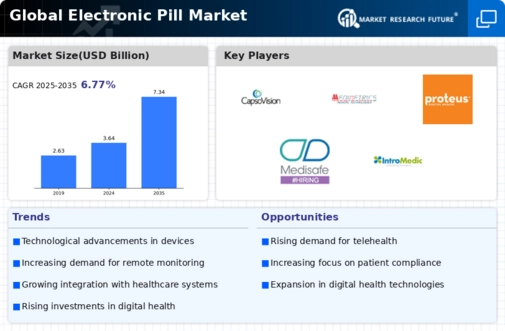Market Trends
Key Emerging Trends in the Electronic Pill Market
The electronic pill industry benefits from faster production of smart pills with sensors and digital technologies. These tablets allow physicians to monitor patients' medication adherence in real time and provide feedback, improving patient management and drug efficacy. Market trends include adding IoT to smart pills. IoT systems combine smart pills to make data transfer between pills and external devices simpler. Comprehensive health monitoring is possible. Smart pill medication monitoring applications are growing in popularity. Patients may easily monitor drug consumption, write notes, and receive tailored alarms using these applications. This fosters patient participation and treatment completion. Electronic tablets increasingly use targeted medication delivery. Electronic pills may aid with individualized medication by improving drug delivery, therapeutic outcomes, and adverse effects by using controlled drug release mechanisms. Wearable technology are being integrated to electronic medications. This allows patients to wear devices that gather and deliver electronic pill data. This method of drug management and health monitoring is non-invasive. Smart pills with sensors that can be ingested are popular. These small sensors, frequently seen in electronic tablets, may monitor digestive system temperature and pH. Doctors learn crucial medication effects from this. New wireless charging and energy harvesting technologies affect smart pill sales. Researchers are developing fake tablets that utilize body energy or wireless charging to last long while being monitored. Artificial pill sales are shifting toward long-term sickness management. These tablets enable 24/7 monitoring and bespoke medication regimes. This is particularly important for diabetics who must follow their medications precisely.
Smart medicines capture health data, therefore data security and privacy are becoming increasingly important. Electronic pill producers are taking significant security and privacy steps to safeguard patient data. Clinical investigations and initiatives are employing electronic pills increasingly. They enable painless monitoring of people's medication compliance and physical responses in real-life conditions for drug research and therapy. Following standards and receiving clearance are crucial in the fake pill sector. Electronic pill manufacturers handle product approval requirements. They want to ensure these new technologies are safe and effective before they enter the healthcare sector. Electronic pill manufacture is improving and becoming cheaper, which benefits the market. These concepts aim to make smart pills cheaper and more accessible so more healthcare systems can adopt them and everyone can obtain better medication monitoring solutions.








Leave a Comment